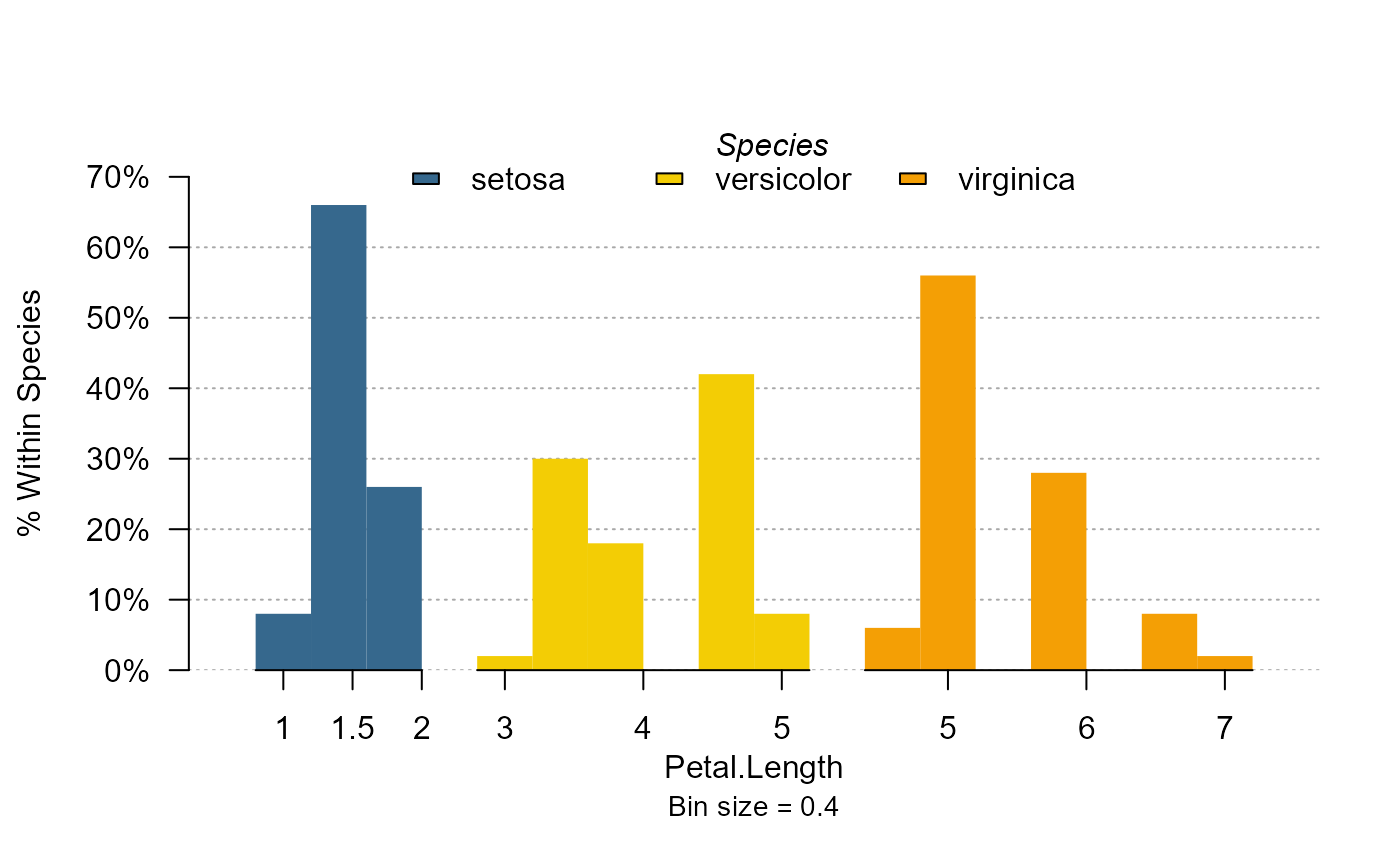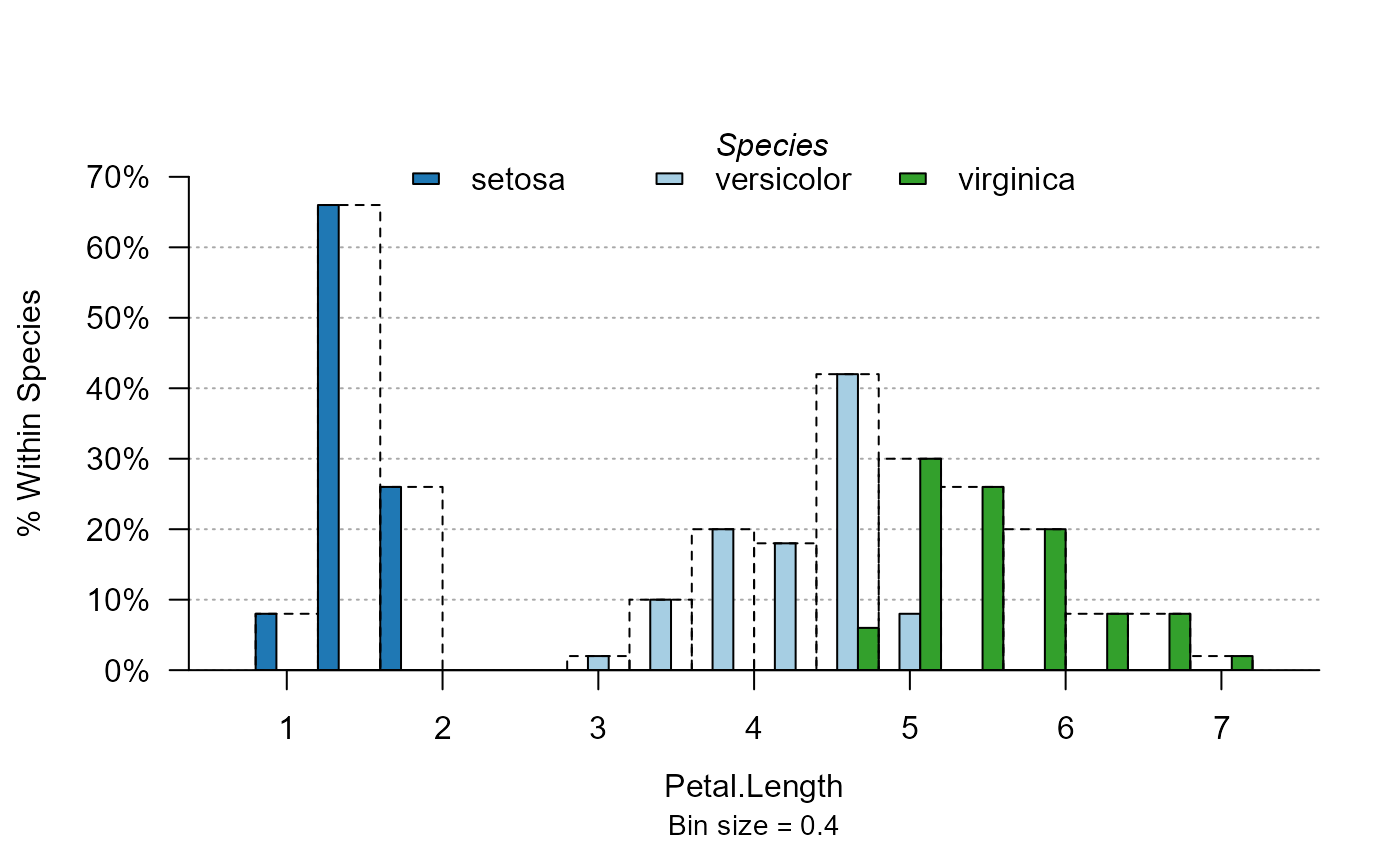Sets the defaults of plot_distr
setFplot_distr.RdThe default values of most arguments of plot_distr can be
set with setFplot_distr.
setFplot_distr(
sorted,
log,
top,
yaxis.num,
col,
border = "black",
mod.method,
within,
total,
at_5,
labels.tilted,
other,
cumul = FALSE,
centered = TRUE,
weight.fun,
int.categorical,
dict = NULL,
mod.title = TRUE,
labels.angle,
cex.axis,
trunc = 20,
trunc.method = "auto",
reset = FALSE
)
getFplot_distr()Arguments
- sorted
Logical: should the first elements displayed be the most frequent? By default this is the case except for numeric values put to log or to integers.
- log
Logical, only used when the data is numeric. If
TRUE, then the data is put to logarithm beforehand. By default numeric values are put to log if the log variation exceeds 3.- top
What to display on the top of the bars. Can be equal to "frac" (for shares), "nb" or "none". The default depends on the type of the plot. To disable it you can also set it to
FALSEor the empty string.- yaxis.num
Whether the y-axis should display regular numbers instead of frequencies in percentage points. By default it shows numbers only when the data is weighted with a different function than the sum. For conditionnal distributions, a numeric y-axis can be displayed only when
mod.method = "sideTotal",mod.method = "splitTotal"ormod.method = "stack", since for the within distributions it does not make sense (because the data is rescaled for each moderator).- col
A vector of colors, default is close to paired. You can also use “set1” or “paired”.
- border
Outer color of the bars. Defaults is
"black". UseNAto remove the borders.- mod.method
A character scalar: either i) “split”, the default for categorical data, ii) “side”, the default for data in logarithmic form or numeric data, or iii) “stack”. This is only used when there is more ù than one moderator. If
"split": there is one separate histogram for each moderator case. If"side": moderators are represented side by side for each value of the variable. If"stack": the bars of the moderators are stacked onto each other, the bar heights representing the distribution in the total population. You can use the other argumentswithinandtotalto say whether the distributions should be within each moderator or over the total distribution.- within
Logical, default is missing. Whether the distributions should be scaled to reflect the distribution within each moderator value. By default it is
TRUEifmod.methodis different from"stack".- total
Logical, default is missing. Whether the distributions should be scaled to reflect the total distribution (and not the distribution within each moderator value). By default it is
TRUEonly ifmod.method="stack".- at_5
Equal to
FALSE,"roman"or"line". When plotting categorical variables, adds a small Roman number under every 5 bars (at_5 = "roman"), or draws a thick axis line every 5 bars (at_5 = "line"). Helps to get the rank of the bars. The default depends on the type of data -- Not implemented when there is a moderator.- labels.tilted
Whether there should be tilted labels. Default is
FALSEexcept when the data is split by moderators (seemod.method).- other
Logical. Should there be a last column counting for the observations not displayed? Default is
TRUEexcept when the data is split.- cumul
Logical, default is
FALSE. IfTRUE, then the cumulative distribution is plotted.- centered
Logical, default is
TRUE. For numeric data only and whensorted=FALSE, whether the histogram should be centered on the mode.- weight.fun
A function, by default it is
sum. Aggregate function to be applied to the weight with respect to variable and the moderator. See examples.- int.categorical
Logical. Whether integers should be treated as categorical variables. By default they are treated as categorical only when their range is small (i.e. smaller than 1000).
- dict
A dictionnary to rename the variables names in the axes and legend. Should be a named vector. By default it s the value of
getFplot_dict(), which you can set with the functionsetFplot_dict.- mod.title
Character scalar. The title of the legend in case there is a moderator. You can set it to
TRUE(the default) to display the moderator name. To display no title, set it toNULLorFALSE.- labels.angle
Only if the labels of the x-axis are tilted. The angle of the tilt.
- cex.axis
Cex value to be passed to biased labels. By defaults, it finds automatically the right value.
- trunc
If the main variable is a character, its values are truncaded to
trunccharacters. Default is 20. You can set the truncation method with the argumenttrunc.method.- trunc.method
If the elements of the x-axis need to be truncated, this is the truncation method. It can be "auto", "right" or "mid".
- reset
Logical scalar, default is
FALSE. Whether the defaults should be reset.
Value
The function setFplot_distr() does not return anything, it only sets the default
parameters for the function plot_distr().
The function getFplot_distr() returns a named list containing the arguments
that have been set with the function setFplot_distr().
See also
Examples
# Changing the default color set for plot_distr only
my_col = c("#36688D", "#F3CD05", "#F49F05", "#F18904", "#BDA589")
setFplot_distr(col = my_col, mod.method = "split", border = NA)
plot_distr(~ Petal.Length | Species, iris)
 # Back to normal
setFplot_distr(reset = TRUE)
plot_distr(~ Petal.Length | Species, iris)
# Back to normal
setFplot_distr(reset = TRUE)
plot_distr(~ Petal.Length | Species, iris)
